Most of my raspberry plants have come from friends and family who live where raspberries grow best. The Sunset Western Garden Book says that raspberries grow best in Zones 3-6 and 15-17. These Zones cover the central and northern California coast, and then western Oregon and Washington. In these climates the winter is cool and rainy, and the summer slowly warms up but never gets as hot or dry as down south.
During visits to Eugene and Corvallis and Salem and Vancouver, I always marvel at the flavor, texture, and production of the raspberry plants in their gardens. Some of them never even water their patches. At least that’s what they tell me, maybe just to rub it in.
The primary challenge of growing high-quality raspberries in Southern California is in emulating these climates where raspberries grow best. I’ve gotten better at doing that over the years, and my raspberries do better now. I hope I can help you and yours.
Sun and shade
Blackberries grow wild in Southern California, and raspberries have similar needs to blackberries. (I read that there are also some native raspberries, but I’ve never seen them.) You’ll notice that wild blackberries down here are almost never growing in full sun, out in the open. Up north they do, but down here they often grow near creeks surrounded by many other plants, especially tall trees that provide some shade, or they grow at the canopy edge of a tall tree.

Similarly, you’ll find that raspberries in your Southern California garden do not prefer to grow in full sun, unless you live very close to the beach. If you live close to the beach, you can grow them in full sun. When I lived around a mile from the beach, my raspberries did fine in lots of sun.
However, if you live away from the beach, your raspberries will suffer at times if they’re in full sun. My current garden is twenty miles from the ocean, and my attempts at raspberries in full sun always resulted in some mature berries getting scorched during high heat, particularly in June. I’ve seen the same occur in other inland gardens.
Therefore, if you’re more than a couple miles from the beach, give your raspberries a little shade — especially afternoon shade — in order to allow the berries to fully mature and develop their maximum flavor without being damaged by the heat. One of my neighbors grows her raspberries under shade cloth. I provide shade for my raspberries by imitating nature.
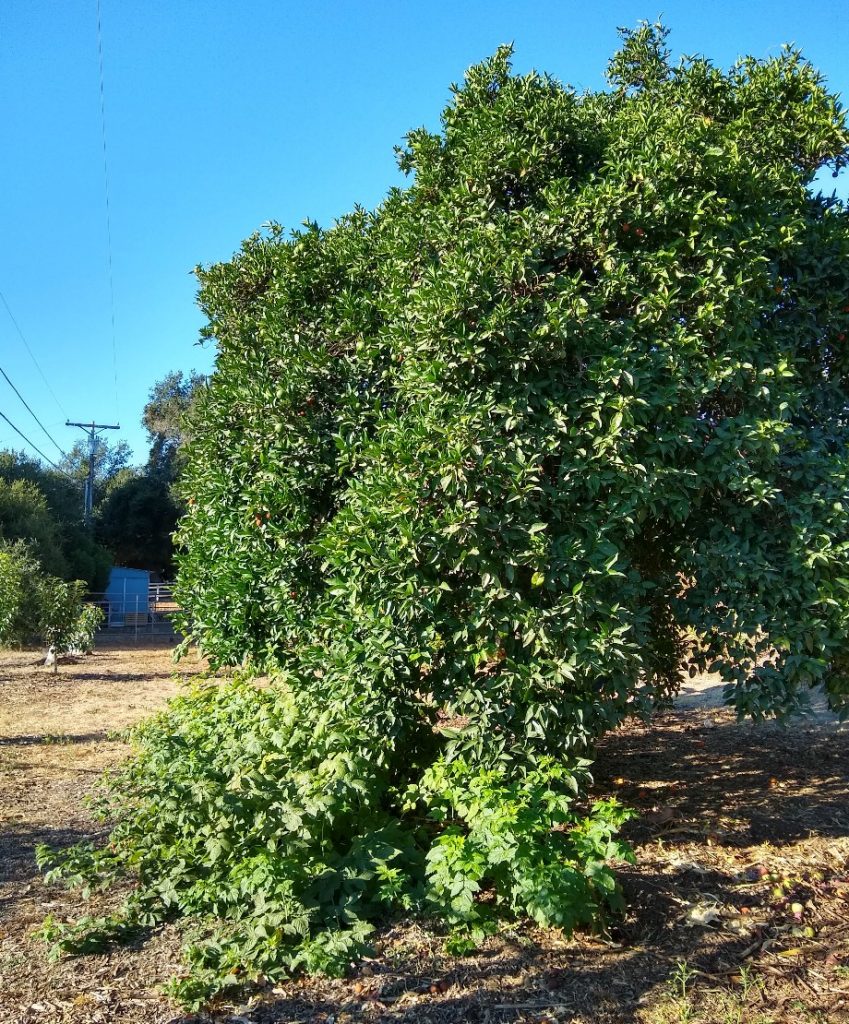
In my yard, I’ve found this to be a sweet spot: at the eastern edge of a large tree. The raspberry plants get full morning sun, and then filtered light the rest of the day. The foliage looks good, the canes fruit well, and the berries slowly develop their delicate texture and rich flavor, if I water well.
Water
Near the beach, the main thing you need to do is make sure your raspberries are watered sufficiently. If you’re getting burned berries in a garden near the beach, it’s likely because you’re not watering enough.
Farther inland like me, you’ve got to give them some shade and plenty of water. Here is another of my raspberry patches:
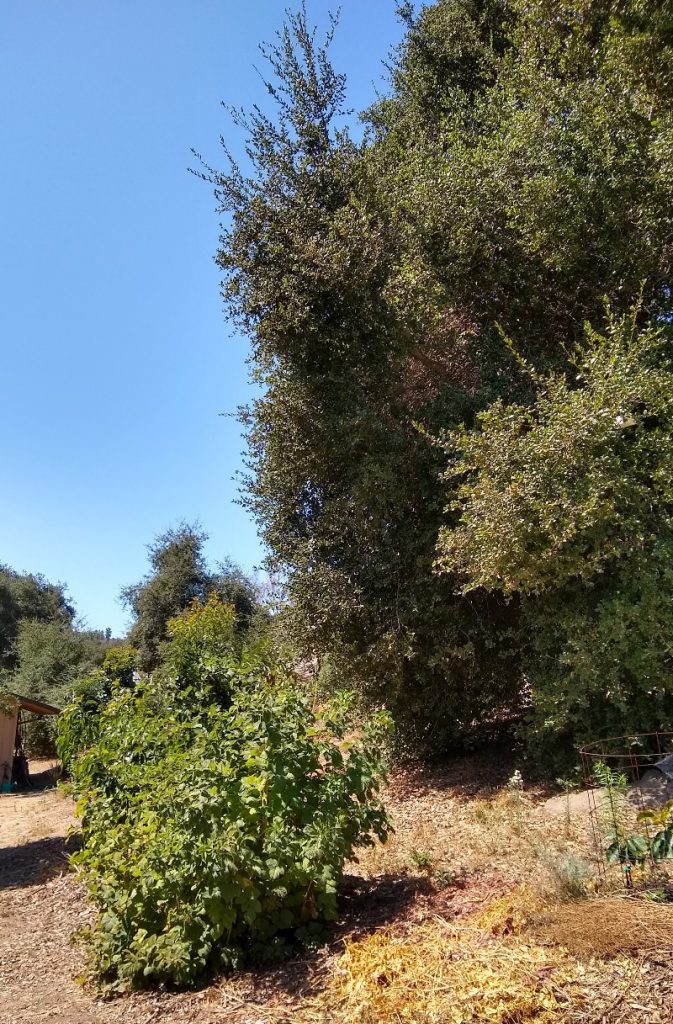
It looks fine from afar, right? But have a closer look:
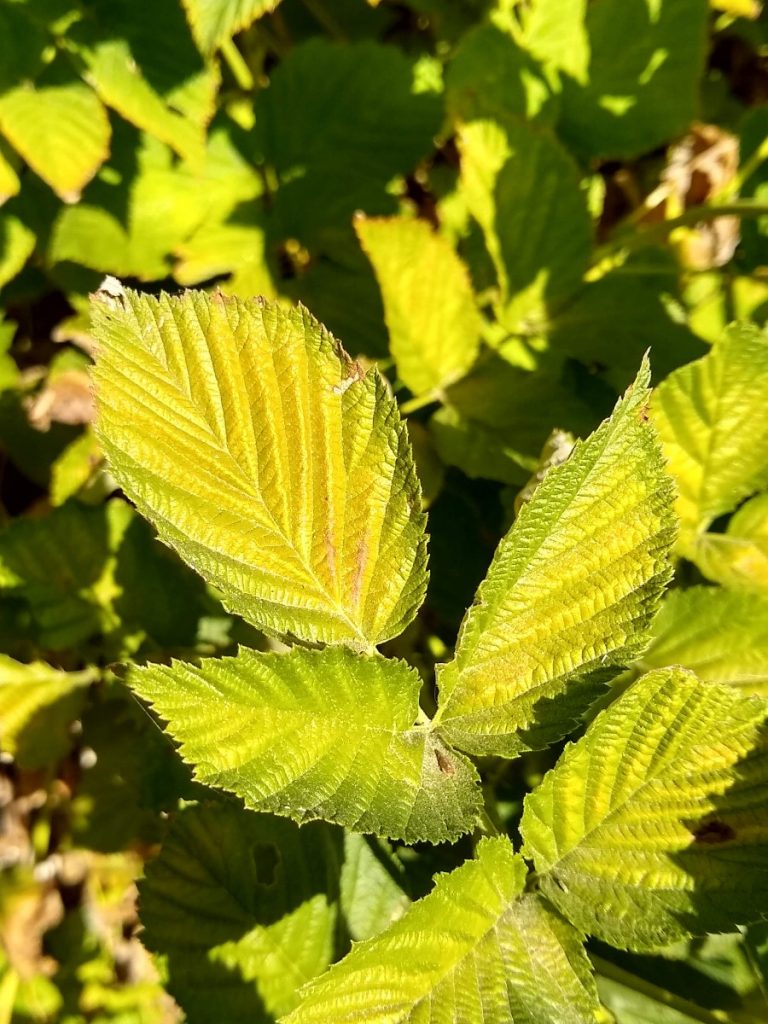
This sunburn was caused by a few 100-degree days, but it was exacerbated by my insufficient watering. What happened was that the dripline I set up to water the patch last year was sufficient then, but I let the patch expand this summer without also increasing the irrigation. Even if you find the right amount of shade for a raspberry plant in your yard, you can’t slack or be stingy with the water and expect the best berries.
The right amount of sun and the right amount of water are the two keys to growing raspberries well in Southern California. Here’s a short video from my yard where I talk about this:
Varieties
The raspberry patch pictured before the video is, incidentally, a variety called Bababerry that is claimed to be heat tolerant. I have not found it significantly more heat tolerant than my other varieties, however. Bababerries need as much shade (and water) as the other varieties in my yard.
Which are my other varieties? No idea, sorry. As I said, they came from old patches in the yards of friends and family up north and I’ve never learned their variety names.
But I’ve never met a poor tasting raspberry, have you? Every variety that I’ve tried has tasted excellent. I’m inclined to believe that getting excellent raspberries from a garden in Southern California is mostly about growing them right and not about growing the right variety.
Actually, I have to qualify that. I’m not a big fan of golden raspberries. The only variety in my yard that I have removed was a golden raspberry because I found it insipid. It just tasted like sugar. I prefer raspberries that taste like raspberries. But I kind of regret removing those plants now because my kids really liked them. Maybe I should plant another golden raspberry.
Planting
The best time to plant raspberries is in winter. Then you can find them at nurseries in quantity and diversity and at the best prices, and the plants settle into their new home in your yard easily. Nevertheless, I’ve planted many raspberries at other times of the year successfully.
How raspberries grow
The enduring life in a raspberry plant is underground, unseen. The canes that arch beautifully above ground and make berries only live for a couple years, but the raspberry’s root system can sprout up new canes indefinitely.
One small raspberry plant will expand to a large patch within a couple years. As it expands, you can either rip out the shoots on the periphery in order to maintain the plant in a small area, or allow the patch to expand. Do remember — as I didn’t — to increase the water as the raspberry patch expands.
I keep my raspberry patches narrow enough such that I can easily reach berries on the interior. That ends up being no more than five feet wide. I maintain this width by periodically putting on a pair of gloves and ripping out shoots that sprout up outside of my invisible border or by mowing shoots that are out of bounds.
Support
Most people provide some kind of structure to support their raspberry plants, which makes harvesting and pruning easier. A common structure entails two posts with a crossbar or two on each, and then wires running between the crossbars. See a drawing of such a trellis system here.
And see one such post and crossbar sticking out of the raspberry patch of my friends in Corvallis, Oregon here:
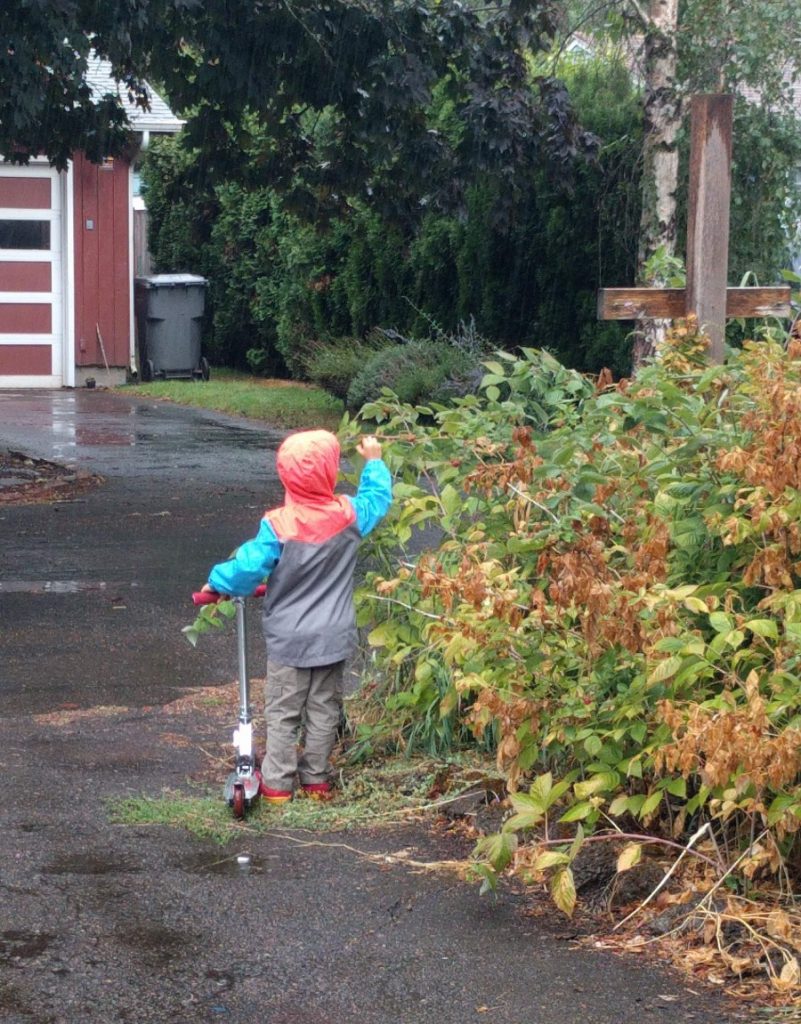
I grow most of my raspberries without support, however. I’m in good company. My mother-in-law grows her raspberries without support up in the Willamette Valley of Oregon, and my mother grows her raspberries the same way in the San Gabriel Valley of Southern California.
I don’t find the need for support structures for raspberries. The main downside of no support is that some canes will droop and some berries will touch the ground. (Varieties differ in how well they stand up or droop.)
If the canes droop, I just lift them up to pick, or to help others pick.
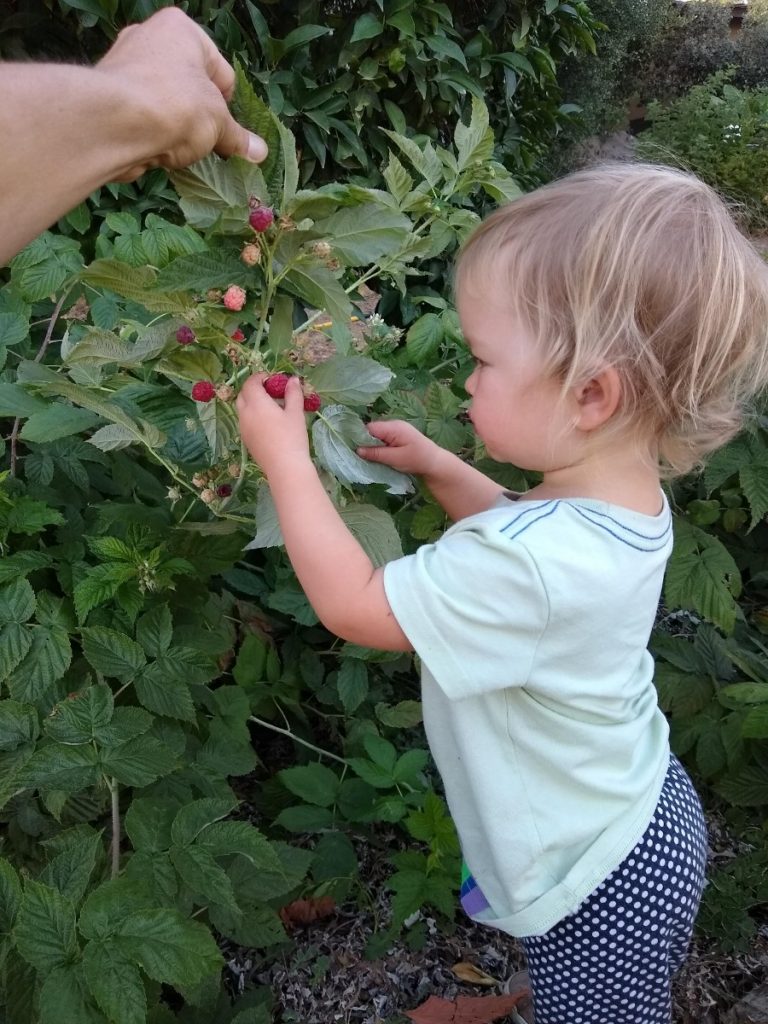
I do grow a single raspberry plant on a stake though. See details about that style in my post, “Growing small blackberry and raspberry bushes on stakes.”
Pruning
Guidance on pruning raspberry plants can sound terribly complicated, with talk of primocanes and floricanes, and fall-bearing and ever-bearing cultivars, and tipping in the summer, and mowing in the winter, and on and on. I used to try to parse and apply such guidance but have since developed my own very simple but effective way of pruning my raspberries: Cut out anything that’s dead.
First, cut out any canes that are dead. How do you know they’re dead? They’re brown, both outside and inside.
Second, cut back any part of a cane that is dead. Sometimes canes die back only partly, not all the way to the ground. Cut back to wherever there is live, green growth. Don’t cut anything that is still green and alive.
I do this pruning in late summer (September) and again in winter.
That’s it. We get lots of berries throughout most of the year from our patches, and this is the only pruning method I use.
Even though we don’t live in the ideal raspberry-growing climate here in Southern California, I’m convinced that most of our yards can produce a fine raspberry crop. The keys are giving the plants plenty of water and not too much sun.
All of my Yard Posts are listed HERE

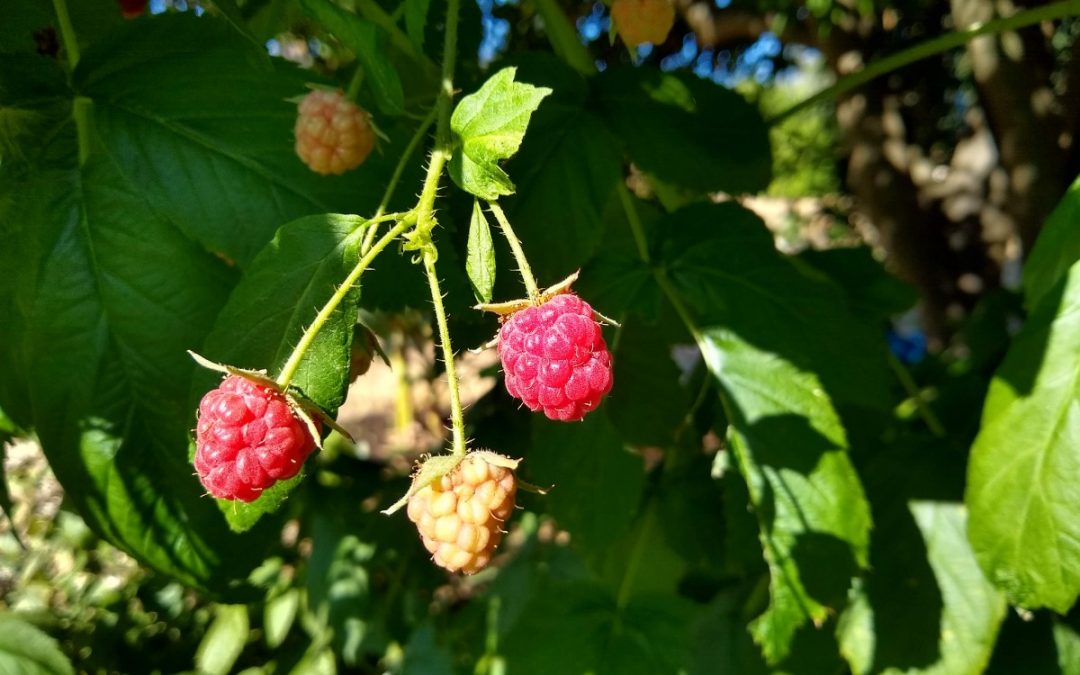


Thank you! I recently bought a raspberry plant (golden 🙂 at El Plantio. I live in Valley Center, where it can get HOT and I was wondering where I should plant it. It’s been sitting in its pot since I bought it two months ago. I’ll wait until it cools down and then plant it in the afternoon shade of a huge oak tree we have. Can you grow different varieties in the same patch? I was thinking of getting a few different kinds and planting them in the same spot.
Hi Emily,
That sounds like a great idea. You can definitely plant different varieties nearby. My golden raspberries grew right next to some other raspberries. They were actually planted near the east wall of my house.
Any suggestions regarding where tk buy rasberry bushes? Also any companion planting ideas? My blackberries love growing with eggplant and kale, their not supposed to but they do love it.
I’m so confused. I cut all my raspberries to the ground last year. I now have a great amount of canes of which some are flowering. They are only 2 to 3 feet high. I understand the crowding issues but I don’t know how to and which canes to chop. Please help me. Thanks
This couldn’t be more timely! We’re in the middle of LA and this fall, we were planning to put raspberries in a 30ft long raised bed along the west side of our house that receives southern sun in the afternoon. Based on your post, I think I’m going to use the shade of our large Valencia tree and plant them on the east side as you have done.
I used to live outside of Portland and miss being able to walk down to the “u-pick” farms with a few old tupperwares and turn my hands red from all the raspberries. Hoping to recreate a little bit of that in the city…
Hi Kristin,
I love when such coincidences happen! Sounds like you would be safer with using the Valencia for afternoon shade. The “U-Pick” berry thing up in Oregon is such a cool tradition that we don’t have down here. Everybody does it, every year, filling their freezers with berries for later. We’ll just have to grow what we can in our own yards, I suppose.
Hi Greg, Do you have any problems with your raspberries spreading to areas of your garden that you don’t want them to spread to? I want to plant more raspberries and blackberries in my yard but am afraid I will find them growing everywhere. And if yours are not spreading, how do you keep them from doing so? Thanks for all your helpful knowledge! I greatly appreciate your help 🙂
Hi Danielle,
Both raspberries and blackberries do spread but in different ways.
Raspberries spread mostly by sending shoots underground that pop up away from the mother plant. I just put on a glove and yank these out. They come out easily. It’s not a hard task to keep a raspberry plant within bounds as long as you pull these shoots consistently.
Blackberries mostly spread by tip layering. Their canes grow like rainbows. They arch up and over and touch the ground, and they root into the soil where they touch it, provided that spot of soil is moist. If you just keep the canes upright or look out for these rooting tips, blackberries are also easy to prevent from spreading too far. Again, consistency is key.
This is all for Southern California though. If you live in a climate with more rain and lower summer temperatures, then controlling the spread of these is more work.
Raspberries spread through spreading roots and their roots are very sensitive – they don’t like the soil messed with where they grow. My raspberries grow on a fenceline at the bottom of a slight hill. Every year about this time (actually mid March) I scatter compost & manure on the edge of where I want the raspberries to stop, then I run my tiller down the row right on the edge – not only killing the roots – but stunting the ones nearby – causing the root network to focus on the plants closest to the fence. Then I cover the tilled area in mulch. Over time the fertilizer runs downhill into the raspberries. Seems to work well so far – keeps them fed & keep s them under control. I also cut out things that I think are 3 years or older – so there’s always 1 year growth, 2 year growth, & three year growth randomly spaced; the trimmings I run through a chipper right back into the vines for mulch.
So epic! I was researching raspberry gardens and found your site. Stoked.
James! Come visit and I’ll give you raspberry starter plants.
Hi Greg ,
Love your article. My question is can we grow a Raspberry plant in a large pot or half barrel? Eastside of our house.
Hi Alan,
Yes, definitely. A friend has grown his raspberries in a half wine barrel for many years with good results.
Eureka! There is concrete in what would be “best conditions for berries in my tiny yard. Will a 15 gallon grow cloth work? Any idea when the local nurseries start bringing in raspberries? Thanks for all the amazing info on your site
Thanks, Iris. You could definitely grow raspberries in a 15-gallon container, but they would be happier in the long run in something more like 30 gallons. There’s an ample supply of new raspberry plants in nurseries starting around Christmas.
Monrovia’s “Raspberry Shortcake” raspberry is a bushy variety that grows especially well in a container. Easily found in Southern CA, not sure about other parts of the country.
Hi Teri,
At you growing this variety? How is it going, and how is the quality of the berries?
Greg, I bought it as a 1 gallon and I’m growing it in a 20″ terra cotta container. My in ground raspberry is fruiting like crazy, but this one hasn’t produced any fruit yet–maybe next year. I’d post a photo but I don’t see how to do that in the comments.
Thanks, Teri. If you can remember, let us know what it does next year.
Hi Teri – Happy New Year. I’m super curious if this variety worked out for you. I’m considering putting some raspberries in and this one was on the list. I’m also in SoCal so it would be interesting to know. Thanks!
Such a great article! (I subscribed to your email list).
I’m trying to revive a poor blackberry plant I’ve subjected to socal full sun for years. It’s in a large planter, so I moved it to a shadier place and it’s looking very happy now. I don’t suppose you have any tips on soil quality? I recently amended the soil and from what I can tell, it’s pretty happy with that as well. I feel like the better soil is helping mostly because it retains moisture so well.
Do you happen to have any experience with grape vines? California natives in particular.
Hi Betsy,
Thanks! That makes sense about the soil. I’ve noticed similar things in my yard, and I’ve noticed that where cane berries grow so well without irrigation — yet in full sun — up north they are often in heavier soils than my sandy loam.
I do grow a number of grapevines, including the species that is native to Southern California (Vitis girdiana). Here is a post I wrote about them four years ago: https://gregalder.com/yardposts/grapevine-on-eave-to-shade-house/
Those vines on my eaves are still doing very well today and I never irrigate them directly.
I wrote this post about the table grapes that I grow on my chain link fence: https://gregalder.com/yardposts/growing-grapes-on-a-chain-link-fence/
And this post is about propagating grapes from cuttings, which is the way I’ve acquired almost all of my grapes, native and other: https://gregalder.com/yardposts/propagating-grapes/
Greg: I read your article on propagating grapes. I have done some the same way, but it works about 60% of the time (roughly, maybe a bit more), I have another way that works 100% of the time. When my grapes send out a new shoot from the root, I let it grow up a bit, then bend it over and bury a portion of the new growth closest to the root, nick the buried portion and let it be for at least a month or longer. The buried portion will grow roots. After a month or two, cut the growth free from the original root, dig up the new root ball and transplant to its new home or to a pot. I do this every year & gift them to friends & family; I love the fact that everyone I know has grapes and the story of them starts at my vines. I have 30 vines, each year I take one growth from every other vine, so I get 15 new plants each year (I trim off all the other new growth so it doesn’t drain the plants – each year I take 1 and use it to replace the oldest vine, then I give the rest away (I may have to keep more at some point, but so far my oldest vine is about 10 and still producing well). Incidentally I do strawberries similarly – when runners go out I set them in a pot with with good soil & compost and water them, I leave them connected to the main vine while they grow new roots, then I cut the runner and they stand alone (when possible I take 3 – 4 runners from different sources and put them into one pot so when I cut the runners I have 4 new plants with their own roots in a pot – when you gift it the new person can use this to start their own patch from 4 separately rooted plants). I do about 10 of these a year, 3-4 I keep & use to keep my own patch fresh, 6-7 I give away.
Hi Chuck,
Thanks a lot for sharing this. I’m going to try it with grapes and strawberries this year.
I have a Raspberry Shortcake in a 5 gal bucket and it fruited for the first time this year. It’s on its 2nd year. Only got a couple raspberries off it….but that’s fine with me. I also have a much larger Loganberry.
Thank you so much for your helpful perspective! We are moving onto my parents’ property in north SD county, and I am excited to put their 6 acres to use…but getting overwhelmed with all the garden expert talk. I appreciate your layman advice (ie just yank out the shoots and prune anything dead!) I’m heading over to your articles on chain link grapes and blueberries next! And then avocados!
Hi Rachel,
Exciting to have six acres to work with! You’ve got a lot of delicious fun ahead.
Thanks so much, Greg. Looks like I will rededicate a partially shaded area on the hill for berries. I had no idea of the shade requirement. We had wild berries of some sort growing up all over the Whittier hills and ravines that we “toured” as kids, but looking back they were all meeting that requirement. Great job on information once again!
Thanks for this article! When do you do your simplified version of pruning?
Hi Charla,
Good question. I should’ve mentioned that. (Just edited it in.) I do it twice each year: once in late summer (around September) and once in winter.
I will be planting raspberries in area that will provide afternoon shade. Would this area also be good for blackberries?
Hi Doug,
Yes, blackberries also grow well with morning sun and afternoon shade.
Thank you for your very informative and easy to follow directions about pruning raspberries. However, I have two questions:
1) Do I trim back any of the vines that still have leaves to contain growth, or do I just let them grow? Will berry production still be good if I trim back the vines?
2) When I fertilize, do I fertilize the offshoots as well? Do the offshoots produce many berries as much as the original primocane?
Hi Vicky,
1) It’s up to you. Trim them back if you want them shorter. Regardless, if they’re alive, they will produce berries when it’s their time.
2) The offshoots are exactly like the mother plant, and they’ll produce exactly like the mother plant, once they’re mature. Many people don’t bother fertilizing cane berries because the plants are plenty vigorous and productive without the help. I’ve never fertilized a raspberry plant myself although I do provide them with mulch at their base. The offshoots are connected to the mother plant through the root system so if you do fertilize the mother, the fertilizer will be reaching the offshoots as well.
Hi! I live in LA, at the border of sunset zones 21 and 23. Can I grow raspberries in the shade? I do have partial sun areas, but the shady spot would be more convenient. Also, do you have any recommendations for other summer fruits that aren’t stone fruits?
Hi Victoria,
Sure you can. In the shade, raspberries still produce but not as much as in the sun.
There are a few apple varieties that produce in the summer. Asian pears too. Valencia oranges are summer fruit. Many grape varieties are ready in summer.
Hi Greg,
We live a mile from the beach, rarely goes above 80 degrees. For the last two years, my raspberries have put out lots of white blooms but the flowers turn brown and no berry ever forms. Not a single berry either year. This year that was true for 100+ blooms. They are in direct sun, and up against a fence but have you any idea what might cause this? Thanks much for everything you do. I’ve learned so much.
Hi Kevin,
That’s frustrating. I’ve never seen such a thing, exactly. But I have seen that if I’m not watering my raspberries enough, then the flowers will not turn into berries or will only become few and smaller berries. My best guess: try more water, especially during bloom.
Greg, thanks so much for your reply. I’ll up the water and see what happens.
Warm regards,
Kevin
Hi Greg – Is there a specific time you don’t recommend putting raspberries in? I was thinking of trying to get a small bush and putting it into a large pot in dappled sunlight but am wondering if now’s a bad time to do it since they seem to be fruiting right now (i.e. early July). I’m in Irvine btw. Thanks again for all your great advice on this site and also your wonderful calendars.
Hi MB,
Thanks. I would plant a raspberry right now. As long as you keep it well watered, and especially if it has some afternoon shade, the plant should do fine. I saw some great looking raspberry plants at a nursery today — very tempting!
Great! Thank you! I will be on the lookout 🙂
Hi Greg,
While I lived in Massachusetts I had black raspberries growing under a cedar tree where they received no direct sunlight, yet they gave an abundant harvest every year.
As a landscaper can fruits and, to some degree, blueberries have become my go suggestion for areas of partial shade. I’ve had wonderful luck with a blackberry variety called Prime Ark 45, which produces fruit for almost 6 months here in LA. They’ve come out with a new variety called Freedom that lacks thorns, but unfortunately I find it lacks the flavor and vigor of 45.
Hi Greg,
I am in 10a/ 10b Ventura County and have some large pine trees that produce a lot of shade on a sloping hillside. Would that acid from the pine needles be a problem for the raspberries?
Hi Carrie,
Raspberries love acidic soil. My grandmother grew great boysenberries next to pine trees for many years.
Thanks for sharing your knowledge and getting back to me so quickly!
I am now motivated to try a raspberry variety (or two) out here outside of Palm Springs. I have two different varieties of blueberry that have now made it through two summers. One had blueberries this year. I wish I had labeled the variety that fruited because I would like to get a couple more
Love this article! I am thrilled to know I can grow raspberries in Southern California! Thank you for sharing your helpful tips!
I love raspberries and had so many shoots at my old home in Boulder, Colorado. I had large quantities of raspberries to pick every summer. I planted my new bush here at our new home at Lake San Marcos. I’ve been using the shade cloth and trying to make sure it gets enough water. It’s produced about 50 berries so far, but I noticed now that many of the leaves are turning brown. What can I do? Should I cut them off the plant now?
Dear Greg, I live in Hollywood and have numerous raspberry plants, planted approx. 2 years ago. The first year they did very little (except grow), this summer I have prolific new sprouts, and the main plants have reached 4-5ft but I yielded no fruit. Now at least half the leaves are brown, some are beautifully green and now it’s producing some fruit. It’s like summer and fall all rolled into Halloween harvesting. Are the leaves brown and crispy because it’s fall, sunburned, diseased?
I read the other comments about watering it more, I feel it gets quite a lot but perhaps I need a drip system?
Any insight as to why my plants are seasonally challenged would be greatly appreciated.
Best, Jude
Hi Greg, great article thank you.
I keep reading not to plant raspberry and blackberry together do to infestation of disease. I want to mix the two in one area. Hi s this not a good idea?
Hi Mira,
Thank you. I’ve had raspberries and blackberries growing right next to each other for years and never seen a problem so I say give it a try.
? thank you! Excited to try and thank you again for the photos and article(s)
Hi Greg,
Do you prune Blackberries and Boysenberries the same way you prune Raspberries?
Thanks!
MB
Hi MB,
No, I don’t. There’s no single best way to prune all these cane berries that works for everyone, but in my situation I use the simple method described in the post above for raspberries where I just cut off anything that is dead. (And I also remove suckers that arise outside my designated area for the raspberries.)
For the blackberries and boysenberries, around the end of summer or sometime in the fall, I remove all the dead canes that fruited, cutting them to the ground. Then I tie up or trellis the new canes that grew that summer (which will fruit the following spring/summer), and I also cut them back in length if they’re too long. Over about five feet is too long for my liking.
Thanks Greg! Super excited to get berries going!
Loved rereading this one! I thought i read it very carefully besides waiting for winter to plant. I did read that you almost planted some in july…. I guess march will be okay…. Thank you again and will let you know what happens.
I live near Balboa Park. I tried growing red, golden, and my favorite “BLACK” raspberries. They were in the ground for 3-4 years. They grew, were healthy but hardly produced any berries. I finally pulled them out and planted grapes which are doing well. At the time, I researched chill requirements for raspberries and discovered that the possible reason for the poor production may be that we didn’t get enough chill hours in my location. I don’t find any comments about this and wondered what you thought. Here are a couple of links regarding the topic.
https://ucanr.edu/blogs/blogcore/postdetail.cfm?postnum=9058
https://fruitsandnuts.ucdavis.edu/chill-calculator
IMO chill hour requirements are one of the big things that new gardeners (incl me!) usually mess up on. It’s quite important to find your nearest station and see what they recorded this year and what they’ve recorded in past years. You can play around with this site to get a lot of data and info.
https://ucanr.edu/chillcalc/index.cfm?controller=station&action=index
Chilling portions vs Chill Hours is another complexity where chilling portions is trying to make a “better” model to account for changes in temp throughout the night and day. However, chill hours is a very good start.
I’d also try to find some local (as in very near you physically) nurseries and find an expert there or if you can find a family-run nursery, talk to the owner. You’ll probably get a lot of advice and nuggets of info on what “really” works in your area. Some varieties still produce well or in limited quantities if their chill hour requirements are not perfectly met. Some don’t. There are also micro climates within your backyard. For example, for us, the place we moved into mid-2022 has one side of the yard near a wall that gets quite cold and gets almost no sun in the winter. A lot of our deciduous trees are against that wall and I’m adding more. I suspect I squeeze a few extra chilling hours out because of this.
Best of luck!
-MB